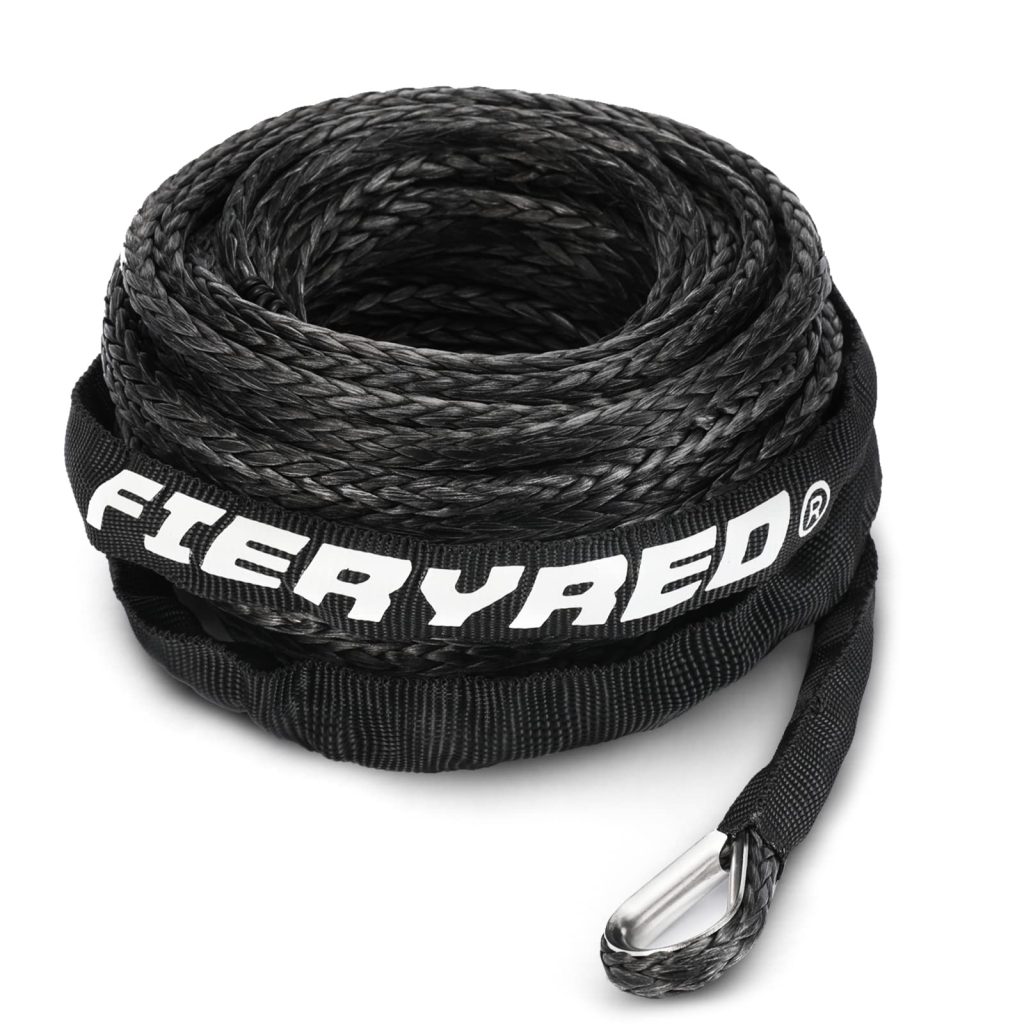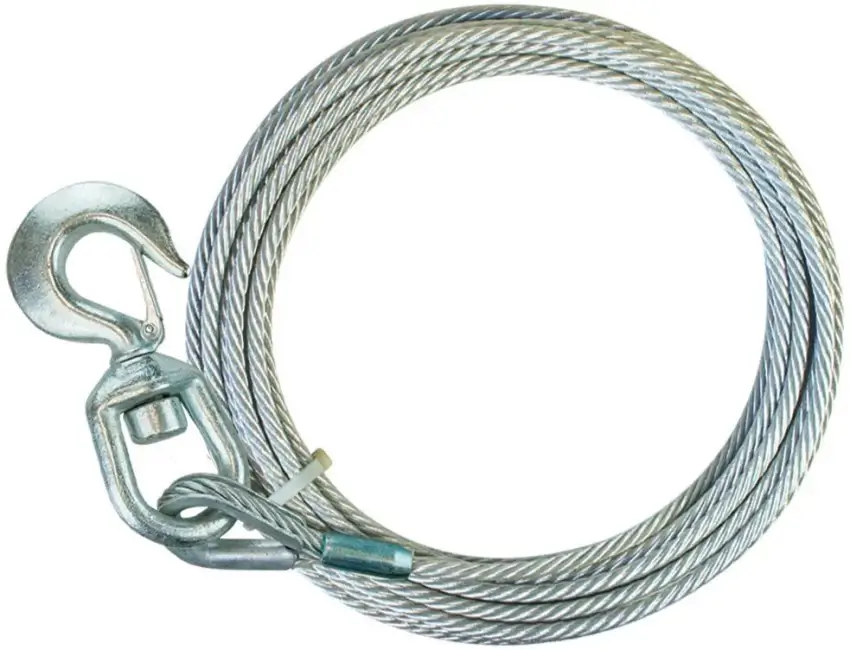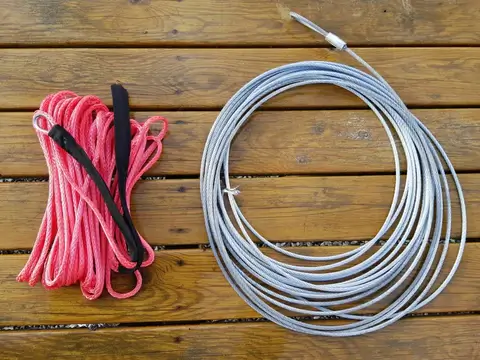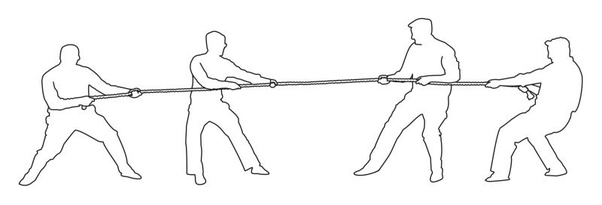When it comes to winching applications, choosing the right rope or cable is crucial for ensuring safety and efficiency. The two primary options are synthetic winch ropes and steel cables, each with its own set of advantages and disadvantages.
In this article, we’ll explore the differences between these materials and help you determine the best choice for your specific needs.
Synthetic Winch Ropes

Synthetic winch ropes are a popular choice for many winching applications due to their unique properties and advantages over traditional steel cables.
These ropes are typically made from high-performance synthetic fibers like nylon, polyester, or ultra-high-molecular-weight polyethylene (UHMWPE).
Advantages
Lightweight Nature
One of the most significant advantages of synthetic ropes is their lightweight construction. For example, a 1/2-inch synthetic winch rope can weigh as little as 6 pounds per 100 feet, while a steel cable of the same diameter can weigh over 20 pounds for the same length.
This lightweight nature makes synthetic ropes easier to handle, transport, and maneuver, reducing fatigue and strain during winching operations.
Exceptional Flexibility
Synthetic winch ropes are renowned for their flexibility, which allows them to bend and spool smoothly without kinking or binding.
This flexibility is particularly beneficial in tight spaces or when working with winches that have small drum diameters.
The supple nature of synthetic ropes also reduces the risk of damage to the winch components and facilitates efficient spooling, ensuring a longer service life for both the rope and the winch.
Resistance to Abrasion, Chemicals, and UV
Many synthetic rope fibers, particularly those made from UHMWPE, exhibit outstanding resistance to abrasion, chemicals, and ultraviolet (UV) radiation.
This resistance enhances the rope’s durability in harsh environments, such as construction sites, mining operations, or offshore applications, where exposure to abrasive surfaces, chemicals, or sunlight is common.
Low Maintenance Requirements
Unlike steel cables, which require regular lubrication and protective coatings to prevent corrosion, synthetic winch ropes have minimal maintenance requirements.
These ropes are inherently resistant to rust and corrosion, eliminating the need for specialized lubricants or coatings. This low-maintenance nature translates into cost savings and reduced downtime for maintenance.
Drawbacks of Synthetic Winch Ropes
While synthetic winch ropes offer numerous advantages, they also have some drawbacks that should be considered:
Lower Strength-to-Weight Ratio
Although synthetic ropes are incredibly strong, they generally have a lower strength-to-weight ratio compared to steel cables of the same diameter.
This means that for the same breaking strength, a synthetic rope may need to have a larger diameter, which can affect its flexibility and handling characteristics.
UV Damage
Prolonged exposure to direct sunlight and UV radiation can degrade the fibers in synthetic ropes, causing them to lose tensile strength over time. This is particularly true for ropes made from nylon or polyester. UHMWPE ropes are more resistant to UV damage but can still be affected by long-term exposure.
Creep and Stretch
Under constant load, synthetic ropes may experience creep (permanent elongation) or elastic stretch, which can affect their performance and accuracy in applications that require precise length control or positioning. This phenomenon is more pronounced in some synthetic fibers than others.
Steel Cables

Steel cables are a traditional choice for winching applications and offer their own set of advantages:
Advantages
High Strength-to-Weight Ratio
Steel cables are praised for their exceptional strength-to-weight ratio, meaning they can withstand high loads while remaining relatively lightweight. This makes them a robust and efficient option for winching.
Abrasion and Cutting Resistance
The section highlights that the metallic construction of steel cables gives them high resistance to abrasion and cutting, which enhances their durability.
Longevity
With proper maintenance, steel cables are noted to have the potential for a longer service life compared to synthetic ropes.
Disadvantages
Heavier Weight
Despite their favorable strength-to-weight ratio, steel cables are generally heavier than synthetic ropes of the same strength, which can be a disadvantage in certain applications where weight is a critical factor.
Corrosion Susceptibility
Steel cables are prone to corrosion, especially in harsh environments or when exposed to moisture or chemicals. This susceptibility to corrosion is a significant drawback compared to synthetic ropes.
Limited Flexibility
The section notes that steel cables have less flexibility than synthetic ropes, which can make spooling and handling more challenging.
Bird-Caging
Under certain conditions, steel cables can experience a phenomenon called bird-caging, where the individual strands separate and protrude from the cable, compromising its integrity and potentially rendering it unsafe for use.
Strength Comparison

When we talk about the strength comparison between synthetic ropes and steel cables, we’re essentially looking at how much load each type of material can handle before it fails or breaks.
This capability is critical in determining which material is suitable for specific winching tasks, especially when dealing with heavy loads or demanding recovery operations.
Breaking Strength
The “breaking strength” of a winch rope or cable is the maximum amount of force it can withstand before it breaks. This figure is vital for safety and efficiency in winching operations.
Strength-to-Weight Ratio
The strength-to-weight ratio is a key factor in choosing between synthetic ropes and steel cables. This ratio measures the material’s strength relative to its weight, indicating how much load the rope or cable can carry per unit of its own weight.
- Steel Cables: Known for their high strength-to-weight ratio, steel cables can handle substantial loads even when they are relatively thin. This makes them an excellent choice for applications where strength is paramount, and weight savings are beneficial, such as in industrial settings or heavy-duty recovery operations. The composition of steel cables, including their core and wire construction (such as IWRC or XIPS), contributes significantly to their overall strength.
- Synthetic Ropes: While synthetic ropes may have a lower strength-to-weight ratio compared to steel cables of the same diameter, they offer a unique advantage. Through the use of materials like UHMWPE (Ultra-High Molecular Weight Polyethylene), synthetic ropes can achieve high breaking strengths that are competitive with or exceed those of steel cables, especially when larger diameters are used. The lighter nature of synthetic materials allows for this high strength without the added weight, making synthetic ropes a favored option in applications where ease of handling and weight reduction are crucial, like off-road recovery.
Diameter and Construction Impact
Both the diameter and the construction of the rope or cable significantly influence its breaking strength. Larger diameters generally provide higher breaking strengths, as there’s more material to distribute the load. This principle applies to both synthetic ropes and steel cables, though the specific impact varies based on the material type and construction.
- For Steel Cables, the construction type (e.g., IWRC, XIPS) can enhance strength and durability. The arrangement and number of wires, as well as the presence of a core, play critical roles in determining the cable’s overall capacity to withstand loads.
- For Synthetic Ropes, advancements in fiber technology and the way fibers are woven or braided together have a substantial effect on their strength. Innovations in materials science have enabled synthetic ropes to achieve high levels of strength that are suitable for a wide range of applications, even those traditionally dominated by steel cables.
Who Wins in Strength Comparison?
In the comparison of strength between synthetic ropes and steel cables, declaring a winner is nuanced, as each has its domains where it excels based on the specific needs of the application:
- For High Strength-to-Weight Ratio and Durability in Heavy-Duty Applications: Steel cables are the winner. Their superior strength-to-weight ratio makes them ideal for industrial, mining, and construction applications where heavy loads and abrasive conditions are common.
- For Lightweight, Ease of Handling, and High Strength in Versatile Applications: Synthetic ropes take the win. They offer comparable or superior breaking strengths in larger diameters, with the added benefits of being lighter and easier to handle, making them perfect for off-road recovery and other situations where weight and flexibility are crucial.
Weight Comparison

When it comes to winching, the weight of the material used for the rope or cable plays a pivotal role, especially in applications where every pound matters.
This is particularly true in scenarios like off-road recovery or when using portable winching systems, where the ease of handling and the total weight of the equipment can significantly impact performance and usability.
Synthetic Winch Ropes: A Lighter Alternative
Synthetic winch ropes, made from materials such as UHMWPE (Ultra-High Molecular Weight Polyethylene), offer a substantial weight advantage over traditional steel cables.
This reduction in weight does not come at the cost of strength; thanks to advances in synthetic fiber technology, these ropes can achieve similar or even superior breaking strengths compared to steel cables of the same diameter.
The lightweight nature of synthetic ropes makes them easier to handle and manipulate, which can be a crucial factor in emergency situations or during solo winching operations.
Additionally, the reduced weight contributes to less strain on the winching system and the vehicle, leading to better overall performance and efficiency.
Steel Cables: The Traditional, Heavier Option
Steel cables, while known for their durability and high strength-to-weight ratio, are inherently heavier than their synthetic counterparts.
This added weight can make steel cables more cumbersome to handle and work with, especially in situations where rapid deployment and retrieval of the winch line are required.
The heavier nature of steel cables also adds to the total load being handled by the winch and the vehicle, which can be a disadvantage in situations where weight savings are crucial, such as off-roading or when payload capacity is limited.
Impact on Applications
The significance of the weight difference between synthetic ropes and steel cables extends beyond just handling and performance.
It also affects the fuel efficiency of vehicles, the wear and tear on winching equipment, and the ease of storage and transport.
In applications where mobility, speed, and efficiency are key, the lightweight advantage of synthetic ropes is undeniable.
Who Wins in Weight Comparison?
- For Weight-Sensitive Applications: Synthetic winch ropes are the clear winner, offering significant weight savings without compromising on strength. They are ideal for off-road vehicles, portable winching systems, and any situation where ease of handling and reduced load are paramount.
- For Traditional Strength and Durability: While steel cables are heavier, they remain a strong contender in applications where weight is less of a concern and where their durability and resistance to harsh conditions are valued.
Flexibility and Spooling

The flexibility of the material used in winching significantly affects the ease of operation, particularly when it comes to spooling the rope or cable onto the winch drum.
This aspect of winching can influence not just the immediate ease of use but also the long-term maintenance and performance of the winching system.
Synthetic Ropes: Pliable and User-Friendly
Synthetic winch ropes are known for their exceptional flexibility, a characteristic that stems from the materials used in their construction, such as UHMWPE (Ultra-High Molecular Weight Polyethylene).
This flexibility allows synthetic ropes to be more easily handled, spooled, and deployed, even in challenging conditions or tight spaces.
The pliable nature of synthetic ropes reduces the risk of kinks or tight bends, which can compromise the rope’s integrity and strength.
Moreover, smoother spooling ensures that the rope is evenly distributed across the winch drum, minimizing the chances of overlaps or binds that could lead to damage under load.
Steel Cables: Durable but Stiffer
Steel cables, while highly durable and resistant to wear, tend to be stiffer compared to synthetic ropes.
This stiffness can make steel cables more challenging to spool neatly onto a winch drum, especially if the cable has been used and is beginning to show signs of wear or has been kinked previously.
The process of spooling a steel cable requires more effort and attention to ensure that it lays flat and even on the drum, avoiding overlaps and uneven layers that could lead to snags or damage during operation.
Additionally, the stiffer nature of steel cables can increase the risk of kinking or bird-caging, where the cable becomes deformed, reducing its strength and potentially making it unsafe for use.
Impact on Use and Maintenance
The differences in flexibility between synthetic ropes and steel cables not only affect their initial installation and spooling but also have implications for their ongoing maintenance and usability.
Synthetic ropes generally require less effort to maintain in a ready-to-use state, while steel cables may need more regular attention to ensure they remain neatly spooled and free of kinks or damage.
Who Wins in Flexibility and Spooling?
- For Ease of Handling and Spooling: Synthetic winch ropes win hands down. Their flexibility allows for easier and smoother spooling, reduced risk of kinks, and generally lower maintenance requirements.
- For Traditional Durability with More Maintenance: Steel cables, despite their stiffness and spooling challenges, continue to be used where their durability and resistance to cutting or abrasion outweigh the benefits of flexibility.
Cost Considerations

When evaluating the cost-effectiveness of synthetic winch ropes and steel cables, it’s essential to look beyond the initial purchase price and consider the total cost of ownership, which includes maintenance, durability, and service life.
These factors collectively determine the real value offered by each winching option.
Initial Purchase Price
Synthetic winch ropes typically command a higher initial price compared to steel cables when comparing products of similar strength.
The advanced materials and manufacturing processes involved in producing high-quality synthetic ropes contribute to this cost difference.
These ropes are designed to offer high strength, lightweight, and flexibility, but these benefits come at a premium.
Maintenance Costs
The cost of maintaining winch ropes and cables can significantly impact their overall value over time. Synthetic ropes are generally more resistant to elements like water, UV light, and chemicals, reducing the need for frequent replacements due to wear and tear from environmental exposure.
They are also easier to inspect for damage, which can reduce the likelihood of unexpected failures.
On the other hand, steel cables require regular maintenance to prevent rust and corrosion, including cleaning, inspection, and lubrication, which can add to their total cost of ownership.
Service Life and Durability
The service life of synthetic ropes versus steel cables can vary depending on the application and environmental conditions.
Synthetic ropes, while susceptible to UV damage and abrasion, often offer a longer service life in applications where these factors are managed, thanks to their inherent resistance to corrosion.
Steel cables, though initially more durable in abrasive conditions, can suffer from corrosion over time, which can shorten their lifespan if not meticulously maintained.
Potential Cost Offsets
While synthetic ropes have a higher upfront cost, their lower maintenance requirements and potentially longer service life can offset this initial investment.
In environments where corrosion or severe wear is a concern, synthetic ropes may offer better long-term value, reducing the need for frequent replacements and the associated costs.
Who Wins in Cost Considerations?
- For Lower Initial Investment: Steel cables are the winner, offering a more affordable option upfront for those on a tight budget.
- For Better Long-Term Value: Synthetic winch ropes may win out, as their lower maintenance needs and potential for a longer service life can offset the higher initial cost over time.
Applications
The suitability of synthetic winch ropes versus steel cables for various applications hinges on the specific requirements and challenges of each scenario.
Factors such as the operational environment, the nature of the loads involved, and the practical considerations of winch use play crucial roles in determining the best choice.
Synthetic Winch Ropes: Ideal for Mobility and Resistance to Elements
Synthetic winch ropes excel in situations where their lightweight, flexibility, and ease of handling offer distinct advantages. These characteristics make them particularly well-suited for:
- Off-Road Vehicles and ATVs: In off-roading, the reduced weight of synthetic ropes is beneficial for performance and fuel efficiency. Their ease of handling and spooling is also crucial in situations where quick and efficient recovery is needed.
- Portable Winching Systems: The light weight and compactness of synthetic ropes make them ideal for portable systems where mobility and quick deployment are essential.
- Corrosion-Prone Environments: Synthetic ropes’ resistance to water, UV light, and chemicals makes them a superior choice in marine applications, humid climates, or any setting where corrosion is a concern.
These applications leverage the unique benefits of synthetic ropes to enhance performance, safety, and convenience.
Steel Cables: The Go-To for Heavy-Duty and Abrasive Conditions
Steel cables are favored in more demanding industrial contexts where their durability, high strength-to-weight ratio, and abrasion resistance are critical. These include:
- Heavy-Duty Industrial Applications: The robust nature of steel cables makes them suitable for lifting heavy loads in construction, mining, and manufacturing settings.
- Mining and Construction: The resistance of steel cables to cutting and abrasion is invaluable in environments with sharp edges and rough surfaces.
- Stationary Winching Systems: In applications where the winch remains in a fixed location and weight is less of a concern, the durability and longevity of steel cables are advantageous.
For these applications, the strength and durability of steel cables make them the preferred choice, ensuring reliability and performance under tough conditions.
Who Wins in Applications?
- For Mobility, Flexibility, and Corrosion Resistance: Synthetic winch ropes are the clear choice, offering significant advantages in lightweight applications and environments where their material properties outshine those of steel.
- For Heavy-Duty Strength and Abrasion Resistance: Steel cables take the lead, providing unmatched durability and reliability in industrial, mining, and construction applications where their physical properties excel.
Maintenance and Care
The maintenance and care of winch ropes and cables are critical to their performance, safety, and lifespan.
Both synthetic ropes and steel cables have specific maintenance requirements that, if followed, can significantly extend their useful life and maintain their functionality.
Maintenance of Synthetic Winch Ropes
Synthetic winch ropes, known for their strength and lightweight properties, require careful maintenance to preserve these qualities:
- Regular Inspections: It’s crucial to frequently inspect synthetic ropes for any signs of wear, tearing, or fraying. Catching damage early can prevent rope failure during operation.
- Avoiding Harsh Chemicals and UV Radiation: Synthetic materials can be sensitive to certain chemicals and prolonged exposure to sunlight. Storing ropes away from harsh chemicals and out of direct sunlight when not in use can prevent degradation of the fibers.
- Proper Storage: When not in use, synthetic ropes should be stored in a clean, dry place, coiled or spooled neatly to avoid tangles and kinks. This precaution helps maintain the rope’s integrity and prevents damage.
Maintenance of Steel Cables
Steel cables, while durable and strong, also demand specific care to maintain their robustness:
- Regular Lubrication: Lubrication is essential for steel cables to prevent rust and corrosion, especially in moist or salty environments. The right type of lubricant can also reduce internal friction, extending the cable’s life.
- Inspection for Wear and Damage: Steel cables should be regularly checked for signs of wear, such as fraying, bird-caging (where the cable strands start to separate and form a cage-like structure), or any form of distortion. Early detection of these issues is key to preventing accidents.
- Proper Spooling and Handling: Ensuring that steel cables are correctly spooled onto the winch drum without overlaps or kinks is vital for preventing damage under load. Proper handling techniques, such as wearing gloves and avoiding sharp bends, also contribute to the cable’s longevity.
Who Wins in Maintenance and Care?
- For Easier Maintenance: Synthetic winch ropes win due to their less intensive care requirements and resistance to corrosion, making them more straightforward to maintain over time.
- For Durability with Regular Upkeep: Steel cables, while requiring more frequent lubrication and protection against corrosion, stand out in environments where their physical resilience can be maximized with proper care.
Conclusion
When choosing between synthetic winch ropes and steel cables, there is no one-size-fits-all solution.
The decision should be based on your specific needs, such as the intended application, weight considerations, flexibility requirements, and cost constraints.
Synthetic winch ropes offer advantages in terms of lightweight, flexibility, and ease of handling, making them ideal for applications where these factors are crucial.
However, steel cables are often preferred for their exceptional strength-to-weight ratio, abrasion resistance, and longevity, particularly in heavy-duty or industrial settings.
Ultimately, both synthetic winch ropes and steel cables have their strengths and weaknesses, and the choice will depend on your priorities and the demands of your winching application.

